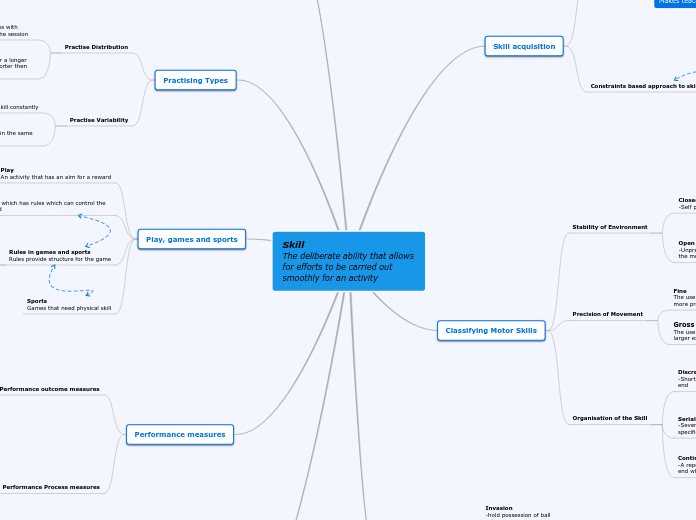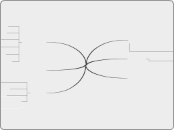Skill
The deliberate ability that allows for efforts to be carried out smoothly for an activity
Types of Motor Skills
Specialised Motor Skill
-Distinct version of Fundamental motor skill which we can apply to certain sports
Fundamental Motor Skill
-basis for young people to allow them to develop the skill of specialised motor skill
Performance measures
Performance Process measures
Indicates how leaners produce the performance and the process
Relates to
Observation of performance and subjective ratings of movement form
Nervous system
Muscle activation
Movement technique
Performance outcome measures
Indicates the results of the performance
Relates to measure of
Consistency
Accuracy
Frequency
Distance
Speed
Play, games and sports
Sports
Games that need physical skill
Rules in games and sports
Rules provide structure for the game
Secondary rules
Changes to the game that do not change the whole nature of it only parts of it
Examples
-Tie-break in tennis
-Size of the ball in soccer
Primary rules
Identify how the game is going to be played which can eventually result in who wins the game
Examples
-No handling of the ball in soccer
-No throwing the ball in football
Games
A goal directed activity which has rules which can control the way the goal is reached
Play
An activity that has an aim for a reward
Practising Types
Practise Variability
Random Practise
Is the varied sequencing of different motor skills in the same training sessions
Game simulation
Blocked Practise
Involves practising the same skill constantly
Kick to kick
Practise Distribution
Massed Practise
Involves less frequent training sessions that last for a longer period of time with rest intervals between tasks shorter then distributed practise
twice a week two hours a session
Distributed Practise
Involves shorter but more frequent training sessions with more time allocated to rest between tasks during the session
four times a week for 30minutes each session
Stages of Motor Skill Learning
Autonomous Stage
-By this stage the skill has become mainly automatic and the performer no longer consciously thinks about the skill
Associative Stage
-The practise stage the performer is beginning to refine their technique movement pattern as they become more consistent and make fewer errors
Cognitive stage
-The beginning stage where person is mentally trying to comprehend the movement requirements for the motor skill
Game Categories
Target
-Accuracy is the aim which can result in the success
Striking/fielding
-Hit ball away from fielders to increase time to score more runs
Net/wall
-Place ball away from opponent
Invasion
-hold possession of ball
-aim
-Create space
Classifying Motor Skills
Organisation of the Skill
Continuous
-A repetitive movement that has an arbitrary beginning and end which can continue for a long duration of time
-Swimming
-Running
Serial
-Several discrete movements that are linked together in a specific order to perform said skill
-Dance Routine
-Serving in tennis
Discrete
-Short duration of the skill which has a clear beginning and end
-Catching
-Throwing
Precision of Movement
Gross
The use of larger muscle groups which dominantly provide a larger exertion of power/force
-Weightlifting
-High Jump
Fine
The use of the smaller muscle groups which together allow for more precision exertion of force/power
-Typing
-Drawing
Stability of Environment
Open
-Unpredictable environment which is externally paced making the movement adapt to the environment
-Digging in Volleyball
-Tackling in rugby
Closed
-Self paced environment that can be predicted easily
-Playing billiards
-Throwing a dart
Skill acquisition
Constraints based approach to skill acquisition
Definition
Requires the leaner to self organise movement and skill based constraints that are influenced by the goal that the leaner wants to meet
Critical Components
Developing learning environments that couple key sources of environmental information with movement
Manipulating task constraints to encourage Leaners to explore movement solutions
-Leaner directed
-Discovery learning
-Active problem solving
-Learners explore how to overcome problems
-Leaners generate knowledge
-Implicit learning
Examples
-Minor games
-Modified games
-Game sense
Direct approach to skill acquisition
Definition
Requires the coach or instructor to make all the decisions relating to the task
-Directed learning
-Instructor directed
-Leaners told what to do and how
-Reproducing technique
-Explicit learning
Examples
-Isolated skill drills









